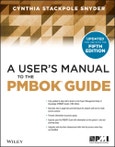The must-have manual to understand and use the latest edition of the Fifth Edition
The professional standard in the field of project management, A Guide to the Project Management Body of Knowledge (PMBOK® Guide - Fifth Edition) published by the Project Management Institute (PMI®) serves as the ultimate resource for professionals and as a valuable studying and training device for students taking the PMP® Exam. A User's Manual to the PMBOK® Guide takes the next logical step to act as a true user's manual. With an accessible format and easy-to-understand language, it helps to not only distill essential information contained in the PMBOK® Guide - Fifth Edition, but also fills an educational gap by offering instruction on how to apply its various tools and techniques. This edition of the User's Manual:
- Defines each project management process in the PMBOK® Guide - Fifth Edition, describes the intent, and discusses the individual ITTOs (inputs, tools and techniques, and outputs)
- Features examples, handy tips, and sample forms to supplement learning
- Contains a data flow diagram of each process in the PMBOK® Guide - Fifth Edition to show how information is distributed
- Is updated to provide deeper coverage of stakeholder management and to include new processes for scope, schedule, cost, and stakeholder management
The User's Manual enables you to put the PMBOK Guide - Fifth Edition to work on your projects. It will help you implement the processes described in the PMBOK Guide - Fifth Edition and apply the tools and techniques to help make your projects successful. Thorough in coverage and rich in content, it is a worthy companion to augment the important strategies laid out in the PMBOK® Guide - Fifth Edition, and the one book that aspiring or professional project managers should never be without.
- Fully updated to align with A Guide to the Project Management Body of Knowledge (PMBOK® Guide)–Fifth Edition
- Describes how to apply tools and techniques for projects and how to create process outputs
- Presents information by process group
- Expands upon the PMBOK® Guide with information on the sponsor's role and planning loops
- Integrates and describes interpersonal skills into the process where they are identified
(PMBOK, PMI, PMP and Project Management Professional are registered marks of the Project Management Institute, Inc.)
Table of Contents
Preface ixAcknowledgements xi
Chapter 1 Introduction 1
About This Book 1
Project Management Process Groups 2
Project Management Knowledge Areas 4
Chapter 2 Key Concepts 7
Projects, Programs, and Portfolios 7
Project Life Cycles 8
Progressive Elaboration 9
Tailoring 9
Enterprise Environmental Factors 9
Organizational Process Assets 10
Chapter 3 Initiating a Project 13
Initiating Process Group 13
Project Sponsor Role 13
Project Manager Role 14
Develop Project Charter 15
Identify Stakeholders 18
Chapter 4 Planning Integration 23
Planning Process Group 23
Planning Loops 24
Project Integration Management 25
Develop Project Management Plan 26
Chapter 5 Planning Scope 31
Project Scope Management 31
Plan Scope Management 32
Collect Requirements 35
Defi ne Scope 43
Create WBS 46
Chapter 6 Planning the Schedule 53
Project Time Management 53
Plan Schedule Management 54
Defi ne Activities 56
Sequence Activities 59
Estimate Activity Resources 63
Estimate Activity Durations 68
Develop Schedule 73
Chapter 7 Planning Cost 85
Project Cost Management 85
Plan Cost Management 85
Estimate Costs 88
Determine Budget 94
Chapter 8 Planning Quality 99
Project Quality Management 99
Plan Quality Management 101
Chapter 9 Planning Human Resources 111
Project Human Resource Management 111
Plan Human Resource Management 112
Chapter 10 Planning Communications 117
Project Communications Management 117
Plan Communications Management 117
Chapter 11 Planning Risk 123
Project Risk Management 123
Plan Risk Management 124
Identify Risks 129
Perform Qualitative Risk Analysis 134
Perform Quantitative Risk Analysis 138
Plan Risk Responses 142
Chapter 12 Planning Procurement 147
Project Procurement Management 147
Plan Procurement Management 148
Chapter 13 Planning Stakeholder Management 157
Project Stakeholder Management 157
Plan Stakeholder Management 157
Chapter 14 Executing the Project 161
Executing Process Group 161
Direct and Manage Project Work 162
Chapter 15 Executing Quality Management 167
Perform Quality Assurance 167
Chapter 16 Executing Human Resource Management 173
Acquire Project Team 173
Develop Project Team 176
Manage Project Team 181
Chapter 17 Executing Communications Management 187
Manage Communications 187
Chapter 18 Executing Procurement Management 191
Conduct Procurements 191
Chapter 19 Executing Stakeholder Management 197
Manage Stakeholder Engagement 197
Chapter 20 Monitoring and Controlling the Project 201
Monitoring and Controlling Process Group 201
Monitor and Control Project Work 202
Perform Integrated Change Control 205
Chapter 21 Monitoring and Controlling Scope 211
Validate Scope 211
Control Scope 213
Chapter 22 Monitoring and Controlling the Schedule 217
Control Schedule 217
Chapter 23 Monitoring and Controlling Cost 221
Control Costs 221
Chapter 24 Monitoring and Controlling Quality 231
Control Quality 231
Chapter 25 Monitoring and Controlling Communications 237
Control Communications 237
Chapter 26 Monitoring and Controlling Risks 241
Control Risks 241
Chapter 27 Monitoring and Controlling Procurements 245
Control Procurements 245
Chapter 28 Monitoring and Controlling Stakeholder Engagement 251
Control Stakeholder Engagement 251
Chapter 29 Closing the Project 255
Closing Process Group 255
Close Project or Phase 255
Close Procurements 258
Appendix 261
Index 289







